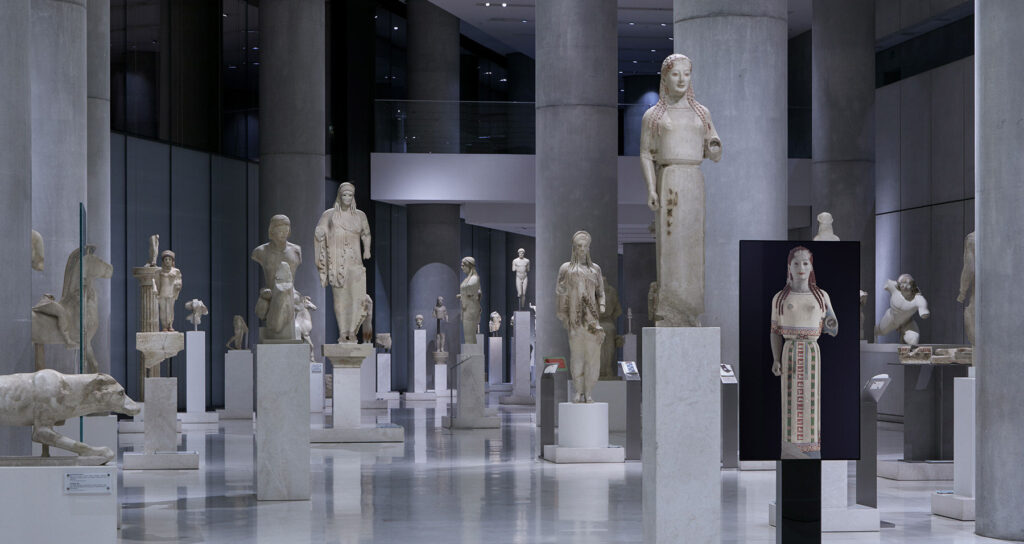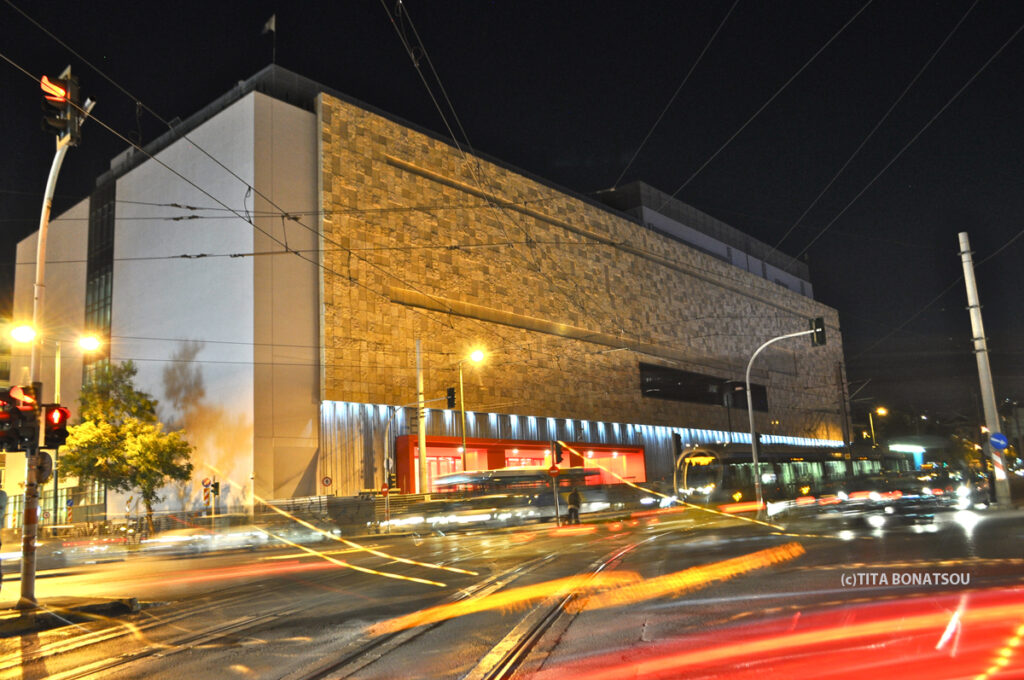By Socratis Santik Oglou,
Athens, the birthplace city of western civilization, democracy, and classical art; now, in 2022 at its concrete big-city form, Athens still hosts its ancient but newer history too in its museums. Rich in heritage, museums in Athens receive a large number of native, but from all around the world too, visitors on a daily basis. And that comes as no surprise if you consider the history of the country. In this article, you will find the five, in my opinion, must-visit museums in Athens.
1) The Acropolis Museum

The well-known Acropolis Museum focuses on the findings of the archaeological site of the Acropolis of Athens and presents it historically, roughly as it was in the 5th century BC.
The museum is located opposite the emblematic Monument of the Parthenon and is one of the most important and unique museums in the whole world. It has been operating since 2000, in the modern, three-level building of Bernard Tschumi. The building itself, despite all the attention and controversy it attracted for its modern design, while located in the classical area of the Acropolis, is undoubtedly a work of art in itself. It houses more than 4,000 exhibits and antiquities found in the Acropolis area. Its important features are the Archaic Acropolis Gallery and the Parthenon Gallery.
In addition, the museum hosts temporary exhibitions and presentations. It is a go-to destination for tourists and educational excursions of schools, while it has an amazing view of the Parthenon, which can be enjoyed by anyone from the café-restaurant of the museum.
Finally, the museum has amenities such as shops with a wide variety of souvenirs and books, an exploration kit of the museum for children, and very useful audio guide guides. The museum is located just outside the metro station of Acropolis, while the entrance to it is from Dionysiou Areopagitou 15 Street. Acropolis Museum is open to the public every day, Monday to Thursday 9 A.M. to 5 P.M., and from Friday to Sunday, from 9 A.M. to 8 P.M.
2) Museum of Cycladic Art

The Museum of Cycladic Art is housed in two separate buildings, which are connected to each other internally: in the main building, there are the halls of the permanent collections and the new wing of the museum, the Stathatos Mansion, which hosts the temporary exhibitions.
As far as the building itself, the Stathatos Mansion is the work of the architect Ernst Ziller and is one of the most important architectural examples of neoclassicism architecture in Athens.
This museum is an important sample of a museum that represents Cycladic art around the world, with representative samples of figurines and vases, weapons, and tools, as well as pottery of all phases of the Early Cycladic period.
The large collection of the museum consists of works that cover a long chronological period, from the 2nd millennium BC to the 4th century BC, which are classified over the 4 floors of the building. There, you can see decorated vases, stone sculptures, clay figurines, bronze vases, gold jewelry and glassware, and many other objects from the life and culture of the inhabitants of the Cyclades.
The museum is located in the center of Athens, in the area of Evangelismos, in Kolonaki. It is open to the public from Monday to Sunday from 10 A.M. to 5 P.M., except Tuesdays, when it is closed. The central building is located on Neophytou Douka 4 Street, while the Stathatos Mansion is located on Vasilissis Sofias 1 Street & Irodotou Street.
3) The National Archeological Museum

The National Archaeological Museum in Athens hosts some of the most important examples of ancient Greek art and history. It is considered one of the most important museums in the world, as it holds the richest collection of ancient Greek works in the world.
As for the building where the exhibits are housed, it is a neoclassical building that was very popular in Europe at the time and is in accordance with the classical style artifacts that it houses. The initial plan was conceived by the architect Ludwig Lange. However, it was later modified by Panagis Kalkos and the building of the museum was in the hands of Armodios Vlachos and Ernst Ziller.
However, the museum’s original destination was to house all the findings from excavations of the 19th century, mainly from Attica, but also from other parts of Greece. Gradually, it took the form of a central National Archaeological Museum and was enriched with findings from all parts of the Greek world.
This important collection consists of more than 11,000 exhibits, giving its visitors a broad perspective on ancient Greek art, culture, and history.
The museum is located in the center of Athens, in the area of Exarchia, between Epirus Street, Bouboulinas Street, and Tositsas Street, while its entrance is on Patission Street, adjacent to the historical building of the Athens Polytechnic University.
Outside the museum, there is a beautiful café hidden in the museum’s garden, in which, among the plants, emerge neoclassical statues. The museum is open every Wednesday to Monday from 8 A.M. to 8 P.M., while on Tuesdays it is open during the hours of 1 P.M. to 8 P.M.
4) The New National Gallery of Athens — Museum “Alexandros Soutzos”

The New National Gallery, with its new modern building, hosts some of the most important works of Greek visual art, as well as a wide range of Greek art from the 19th century to the 21st century. The works exhibited in the permanent collection of the gallery constitute more than 100 works, while its collection, which is kept in the warehouses of the gallery, consists of simply more than 20,000 works.
The gallery has three floors. The first floor houses the exhibition on the Greek Revolution of 1821 and the Greek art of the 19th century. On the second floor, the visitor will see the later phases of Greek art, with an introduction to the expression of the modern movement. Finally, on the third floor, there is exhibited the art of the 20th and 21st century, with a plethora of modern and postmodern inactive Greek artists of the avant-garde.
Some of the most important artists you will meet there are: Theodoros Vryzakis, Nikolaos Gyzis, Nikiforos Lytras, Panagiotis Tetsis, Chrysa, Nikos Hadjikyriakos-Gikas, Giannis Tahitis, Giannis Spyropoulos, Nikos Lytras, Konstantinos Maleas, and Giannis Moralis.
In addition, the museum has a wardrobe for the visitors’ clothes, an information center, a café-restaurant, a space for temporary exhibitions, an amphitheater, a library, and a training event hall. The gallery is located in the center of Athens, on Vasileos Konstantinou Avenue, opposite the well-known hotel Hilton. The New National Gallery is open to the public all week, except for Tuesday, from 10 A.M.. to 6 P.M.
5) The National Museum of Contemporary Art — EMST

The National Museum of Contemporary Art — EMST is the only state museum specializing in contemporary art in Greece. It began its operation in 2000, while the museum is housed in the former FIX brewery factory on Syggrou Avenue. The museum’s collection consists of modern and postmodern art by Greek and foreign artists of different media — paintings, sculptures, photography, videos, installations, industrial designs, and engravings, which deal with current and diachronic issues. EMST seeks to promote arts education and public awareness for contemporary art, as well as the development of scientific research in that field, while at the same time seeking to bring to the Greek stage new media and trends of international art.
Finally, the museum hosts temporary exhibitions has an event space and a café-restaurant. It is located in the area of Syggrou-Fix, next to the homonymous stop of the metro. The museum is open from Tuesday to Sunday from 11 A.M. to 7 P.M., except from Thursday which is open from 11 A.M. to 10 P.M. The entrance is on Kallirrois Avenue & Amvre. Frantzi, while access for people with disabilities/reduced mobility is from Syggrou Avenue.
To conclude, in Athens, there are more notable museums that you could visit. Like the Benaki Museum, B & Goulandri Foundation, or you can even try the tours that the National Archaeological Museum offers, all the archaeological sights around the center of Athens, like Keramikos and Roman and Ancient Agora — it is like an open-air museum. The Athenian metropolis offers a wide variety of museums and monumental sights for all the lovers of history, culture, and museums, making the city, a go-to destination.
References
- Homepage of the Acropolis Museum, theacropolismuseum.gr, Available here
- Homepage of the Museum of Cycladic Art, cycladic.gr, Available here
- Homepage of the National Archaeological Museum, namuseum.gr, Available here
- Εθνική Πινακοθήκη — Μουσείο Αλεξάνδρου Σούτσου — Παρουσίαση, nationalgallery.gr, Available here
- Μέσα στη νέα Εθνική Πινακοθήκη, lifo.gr, Available here




